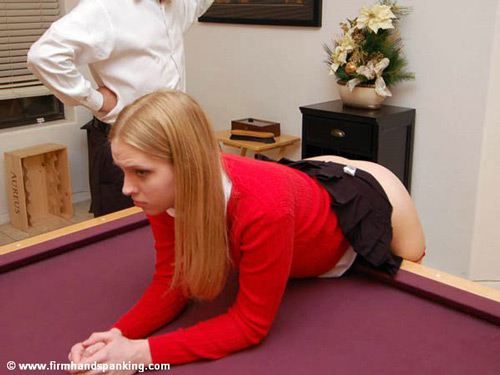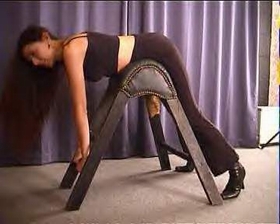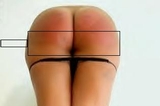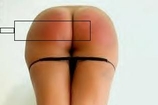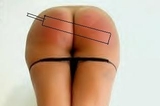|
|
The Spankee is in position with her bottom bared and the Spanker has the implement of choice in his hand -
now what? I like to give some preliminary light taps, leaving the implement in contact with the bottom
for a few seconds after the last tap and just before commencing the first actual stroke. This builds
anticipation and emphasizes one of the humbling aspects of any kind of spanking session, namely that the
strokes are to be applied to a very personal portion of the anatomy. Some spankees like feeling this
preliminary "touch" of the implement, and it can be done at other times that a slow pace is being followed,
for example before "hard" swats (see "How much sting to give" below) or during a sensual-type session.
Aim carefully, then bring the implement backward and immediately forward again. Control is the
object here – the implement must be applied on target and with the correct degree of intensity (to be
experienced as sting by the Spankee). Exactly where to apply the stroke depends on the implement
used, which we now discuss.
Paddle or Strap: these are large enough that I feel each stroke should be applied to the lower
central portion of the buttocks (a narrow strap, a small paddle, the hairbrush or the wood spoon can be
moved around more). If used in this manner, the paddle will produce two round areas of blushing pink,
which should look nearly identical. The strap will produce distinct stripes of its own width unless it
is very wide - strive for evenness and avoid wrapping with this implement.
I once saw a video in which a fairly well-known actor was using a large oval-shaped leather paddle
(a very fine implement, by the way). He applied it high, then low, then repeatedly way over on the
side of the hip, to the Sub’s evident distress. Finally he gave her one swat dead center on the fanny
where it belonged. Unless you are trying to make it a bad experience for the Sub, this isn’t the way to go.
Large paddles cannot be moved around from one location to another - every swat should land very close
to the same place. If you want an extremely fine and delicate control of placement, use a small
implement that can be moved all over the map - a hairbrush, a spoon, a paddle-ball sized paddle,
or a miniature strap.
Cane: By tradition and because we don’t want to injure the skin, the strokes should not be applied
to the exact same spot over and over. Our goal should be a nice, even series of stripes ranging from the
upper portion of the buttocks to the lower – not too high and not on the dividing line between the
buttocks and the thighs. You can go from upper to lower, or vice-versa, or if you want to get fancy,
alternate between upper and lower, ending in the center. As noted above, the tip of the can must not be
allowed to strike the Sub. Position the cane so that the tip extends about 1 - 2” past the right buttock.
With a thin cane, if the tip is extended too far, the cane may wrap around the right hip. A thicker
cane is less flexible, so the tip may be extended a little further if desired, but there is no particular
advantage in doing so. Accuracy in caning is achieved through practice. When just starting out, it is
desirable to practice caning on an inanimate object such as a pillow. Believe me, your canee will be glad
you practiced on something other than her bottom!
Intensity can be controlled in three ways: changing the amount of force used, altering the length
of the stroke, and changing the thickness (hence the weight) of the implement used. Regarding the
last of these, a more thorough discussion will be made in a separate article,
but here are some quick guidelines regarding implement thicknesses:
- Paddle: ¼” wood is light, 3/8’’ wood is moderate, ½” wood is heavy. Actual fraternity or school
paddles are generally ½". For lexan the figures for moderate and heavy would be ¼” and 3/8” respectively,
with 1/4" being strongly recommended. For leather paddles (and straps) no thickness guidelines will
be given here because there are too many variables in the construction of these implements; instead,
they should be thought of and judged in terms of weight.
- Rattan Cane: ¼" is light, 5/16" is moderate, 3/8" and 7/16" are heavy. Bamboo is a
problematic material, while the synthetics nylon, delrin, and lexan should only be used in the 1/4"
thickness!
I have found the most precise control of intensity can be obtained by keeping the amount of force
(muscular exertion) constant, and varying the length of the stroke. Short strokes produce less sting;
longer strokes will give more sting. The length of the stroke is usually determined by how far back the
implement is drawn prior to the stroke, although the length of the implement itself is an important factor.
In the case of the traditional crook-handled cane, it can also be lessened by “choking up” (holding it
further up from the handle), which is the same thing as using a shorter cane.
Those just starting out in spanking would be well-advised to begin with lighter implements. It's not
that heavy implements can't be used, but they do have to be used with care and respect and there is
a tendency among beginning Spankers to use too much force. Lighter implements tend to be a little
"stingier" while heavier ones have more "thud" and also a somewhat greater tendency to bruise.
The warm-up: It is well-established that a good warm-up greatly helps the Sub to take a longer,
harder session. The warm-up is simply a period of lighter spanks, perhaps five minutes of hand spanking or
50 light swats with a paddle. A hand spanking can itself be used as a warm-up for the paddle or cane,
or a lighter paddle can be used before a heavier one, for instance. The warm-up makes the experience
much more comfortable and pleasant for the Sub. The extreme opposite is the "cold" caning (no warm-up
at all), which I would imagine is very unpleasant for the Sub, but there are a few
Puritan-Penitent types out there who seem to think this is the only way to do things. Why does the warm-up
work? It is probably a combination of factors: a loosening of the muscles, capillary dilation (this
is what causes the bottom to redden), and the release of endorphins.
How much sting to give during the main part of the seesion depends on the purposes of the Top
and the Sub: mild stinging is generally more
pleasant and sensual, while a more intense stinging is more disciplinary. Of course this varies with
each individual, and each couple must experiment to find what works for them. I like to start out lightly
and gradually increase the intensity until I reach a point where the Sub makes a little pained
exclamation (“Ouch!”, “Ow!”, etc.), which usually indicates she’s feeling the right amount of sting.
Note that I said “a little pained exclamation”, not “a scream of agony”! Remember that any implement
can be used well or badly, and it’s up to you to know the difference. Be kind to your Sub – if you don’t
genuinely care about her, you shouldn’t be disciplining her at all. It is your responsibility to
play safely, and always use a safeword (a safeword is simply a prearranged signal between the Top and the
Sub, such as the words "mercy" or "red light", that lets the Top know the distress of the Sub is so great
he must stop whatever he's doing immediately). Also, encourage your Sub to let you know if she’s
uncomfortable, even though she may not actually have reached her limit. Non-verbal cues are equally
important, and more so with some rather non-vocal women: watch for any movement of her hips in response
to the stroke; if her hips move, you can be sure she felt the sting! Make adjustments as necessary.
Also, the amount of sting need not be kept completely constant. Let's define a few terms relating to
intensity:
- Sensual - no real sting. Typically achieved with an implement like a fur-covered paddle or
a soft leather flogger.
- Light Sting - the point at which the stinging sensation first becomes perceptible.
- Moderate Sting - the stinging is more intense, but still easily handled by the Sub.
- Comfort Limit - this is the most the Sub can handle without becoming seriously distressed
both physically and emotionally. It definitely smarts quite a bit! A swat at or near this level will
be considered "hard".
- Tolerance Limit - this is the absolute limit of what the Sub can take. Beyond this point
the pain and the fear of injury become alarming to the Sub, and there is definitely some physical
risk. The Sub should sound the "yellow" alert before reaching this point. We most definitely do not
want to exceed this limit for any reason.
Sensual, as the name implies, would normally indicate a sensual-type session. Nonetheless,
Light Sting and even Moderate Sting are appropriate during this type of session, either
after the sensual strokes or alternated with them. Both fun-type and disciplinary sessions should
dwell most of the time at the level of Light Sting and Moderate Sting, with the occasional
swat deliberately pushing up toward the Comfort Limit. An important point for Tops to grasp is
that there may not be much distance between Comfort Limit and Tolerance Limit from the
Top's perspective, even though the difference to the Sub is huge! In other words, a relatively small
increase in force may take you from Comfort Limit to Tolerance Limit.
|
|
|
|
For a paddling, after I reach the point of Light to Moderate Sting described above where the spankee
definitely feels it, I like to hold the intensity right there for a large number of swats! There is
a cumulative effect that I feel is a better way of doing things
than giving her a small number of hard swats at her Comfort Limit. At the same time, both
Tops and Subs enjoy some harder swats near the Comfort Limit every now and then. The session
can be broken up into "sets", say of 25 or 50 swats each, with the last swat being a hard one. It is
good to draw these hard swats out a little to build anticipation. The Top can say something about the next
swat being a "good one", reposition the Sub slightly if desired, give the bottom a few preliminary taps
to represent careful aiming, etc. Or the Top can do a slow count to three: say "One" and carefully
fit the paddle to the Sub's bottom, perhaps with a few pats; say "Two" followed by more fitting; and then
instead of saying "Three" - WHACK! The swat is delivered on target! Nothing could be more fun
than that!
When it comes to caning, I prefer to cane in what is known as "British-style," that is, I proceed in
almost the opposite manner I do with the paddle: a small number of strokes, typically 12 to 18, as near
the Comfort Limit as I can get. (The traditional "six of the best" in British schools were, by all
accounts, given at an intensity that exceeded the Comfort Limit, as prefects, masters, and headmasters
did not generally concern themselves with the canee's comfort). As mentioned above, the caning should
be preceded by a warm up with the hand (the leather paddle works well also).
There are some Puritan-Penitent types (not all) who believe that that only a very intense pain is
appropriate, and that anything less is somehow illegitimate. At the risk of digressing from purely
technical matters to the philosophical realm, let me say I strongly disagree. These people are,
consciously or not, striving to re-create what was obviously an unpleasant and often a traumatic
childhood experience, bordering on abuse (and sometimes crossing the line). Isn’t it better to have
a mutually satisfying, pleasurable, and above all safe experience? There’s certainly nothing wrong
with a session which emphasizes discipline and punishment, but in my opinion this can be achieved
through strictness of manner and by giving enough sting so that the Sub perceives that she is being
disciplined. The point here is that a bringing a pleasurable fantasy to life is far superior to
re-creating an unpleasant reality which, ironically, was probably responsible for warping the Top
and/or the Sub in the first place.
How many strokes to apply: There is no set answer here as it depends on the Sub, the implement,
and the intensity of the strokes. The higher the intensity, the lower the number will be. Actual
school paddlings were generally 3 – 5 swats delivered very hard
with a heavy (typically ½” thick) wooden paddle. Traditional school canings were "six of the best",
delivered pretty much full force, with more strokes being given on occasion. As discussed above, I don't
believe that school paddlings or canings are a good model for an adult spanking session, although
role-playing that re-creates certain aspects of these traditional punishments is certainly fine, as is
reproducing some of the elements that give the "feel" of a traditional punishment. The very use of
such implements as the paddle and cane in the first place is an example of this, along with traditional
positions and phrases such as "bend over". But I feel we should be striving for something much better
than an authentic re-creation of an actual school corporal punishment session could ever be.
As mentioned above, I think the ideal paddling consists of a large number of swats at the level of
Light to Moderate Sting, with a small number of harder swats mixed in. Any woman should be able to
take at least 50 swats like this, with some being able to handle 100 or more (remember that we are
not talking about anything close to full force swats here). A session can be broken up into
distinct sets with rest periods in between, thus allowing for a greater number of swats to be given
in toto. A lot depends on the tolerance of the Sub, and this varies greatly.
The ideal caning is a little closer to tradition, but still not quite as hard. I usually employ only
a wrist stroke, leaving the stronger muscles of the upper arm and shoulder out of play. If necessary,
somewhat more force can be used. Much depends on the length and thickness of the cane, and of course
the tolerance of the Sub. Those desiring a sensual type of session can certainly strive for this by
lessening the intensity of the strokes. But to me, this rather negates the whole point of selecting
the cane as your implement in the first place, since the cane's claim to fame is the rather intense
pain it produces. The cause of sensuality would probably be better served by the birch (not covered
specifically in this article) or an implement of very soft leather.
Sometimes an exact number of strokes is specified right at the beginning of the session. This would
normally be done in two cases:
- The Sub is known to find this especially exciting.
- In the setting of a formal disciplinary session within the context of a Domestic Discipline (DD)
relationship, perhaps resulting from the violation of certain rules which were previously specified and
agreed to.
For example smoking a cigarette could result in 3 cane strokes. We know of one case in which for each
instance of indulging in junk food, a very sweet young lady was assessed 10 swats with the paddle, plus
50 swats for maintenance! Another young woman was once driving around town without wearing her seat belt.
Fortunately, it was a small town, and her caring Top happened to pull up next to her at a traffic light
and noticed the unfastened seat belt. She was busted, and not long afterwards that little joyride cost
her 50 swats on her bare bottom, if we remember rightly. A thorough discussion of the DD lifestyle
is beyond the scope of this article; suffice it to say that the Top in these cases must do his duty
and not let the Sub off the hook, which would greatly disappoint her.
HOW RAPIDLY SHOULD THE STROKES BE APPLIED?
Again, there is no set answer here as it depends on the Sub,
the implement, and the intensity of the strokes. The general rule to remember is that the greater the
intensity, the longer the time in between strokes should be. At the level of Light Sting, the paddle
may be applied with a frequency of up to 1 swat per second. At higher intensity levels, proportionately
more rest time must be allowed. With the cane, 30 seconds in between strokes will let the sting really
sink in and allow time to rest while at the same time build anticipation before the next one. Experience
is the best teacher here. One of the advantages of playing with the same Sub many times is that you
gradually get a feel for what works best for her.
MARKING:
This is a very controversial topic, and there is virtually no agreement within the
spanking community on the subject. First, we must define what we mean by “marking”. Even the mildest
spanking will result in a reddening of the bottom, which will last at most for a few hours. We do not
consider this marking at all. A light session with paddle, strap, or cane will do the same, and in
addition may leave some slight marks that will last at most 24 hours. This should be considered
acceptable by the Sub. A moderate session with these implements may leave slight bruises (paddle, strap)
or welts (also known as weals) with the strap or cane lasting a couple of days. Our view is that this is
acceptable provided the Sub understands that this may occur and is agreeable. We have found that heavier
implements are more likely to bruise than lighter ones, and if a Sub requires a fairly intense sting, we
try to achieve it by applying a larger number of strokes with a lighter implement.
A heavier session can
result in marks lasting for many days or even several weeks, and/or the skin actually being broken.
In our opinion, this is unacceptable even if the Sub understands and agrees to it. We consider that
marking to this extent represents physical injury, and it is always wrong to actually harm someone,
even if that is what she desires. The Top must always place the health and welfare of the Sub above all
other considerations, including whatever desires either or both of them may have. Again, while we note
that not all would agree with this view, we have yet to see anyone come up with a satisfactory
justification for such heavy play. "I felt like it” or “She wanted it to be that hard” or
"That's how it used to be done in school" are not serious moral arguments, only empty rationalizations.
We close our remarks on this subject by mentioning that many women find the idea of being marked strangely
appealing. Note that it is the idea rather than the actual process of marking that has
the appeal, and on closer examination it does make sense when we take into account female psychology as
a whole. Women like to have something tangible to remind them of an important emotional experience,
which is what a session with the paddle, strap, or cane represents to them. This is very much like
having a letter or a present to remind them of a special evening. The marks in this context represent
the man's caring, his concern for her, and the attention he paid her.
COUNTING:
This applies usually to disciplinary-type sessions, although if a couple finds it fun there's no reason for
them not to do it. No general rule can be given - some people love counting, some people hate it, and
some are indifferent to it. If the Spankee enjoys counting, then make her count at least some of the swats
or strokes. Note that I said “make her count”, for being instructed to count the strokes is a very exciting
part of the experience for this type. She wants to be told what to do and made to comply – actually this is
true of any woman into spanking. “Don’t ask her, tell her” is the best advice here and good advice during a
session generally. Tell her how she is to count the strokes for you. Some examples are “One sir,
Two Sir," etc.; ”One, thank you sir, Two, thank you sir,” etc. What if she fails to count a particular
stroke? Then give her the “same” stroke over again and again until she remembers to count it!
WHAT TO SAY DURING THE SESSION:
It is impossible to overestimate the effect that words have on a woman. Women are extremely verbally
oriented – notice that spanking stories are often written with female readers in mind, whereas spanking
pictures and videos tend to have a greater appeal for men. A good pre-spanking lecture is generally
imperative in a disciplinary session. Emphasize what she has done wrong, tell her that this is
unacceptable, and that you are now going to discipline her because you care about her. In both
disciplinary and non-disciplinary sessions, particular words or phrases may carry great emotional weight
with a Sub, for example “this is for your own good.” Why is this so? Usually, the answer lies in
actual childhood experiences or in spanking fantasies that develop during adolescence. Remember, we
often tell a spanked child that the spanking was for her own good, and these words, spoken initially so
long ago, can continue to have great emotional resonance for the adult Spankee. With some women, it can
be regarded as an absolute necessity to actually use the words “this is for your own good” or
“I’m going to spank you now for your own good” etc. Some other examples of phrases that are important
for certain Subs are “You’ve been a (very) bad girl”, “Turn over my knee”, “Bend over”, “Assume the
position”, “Look straight ahead”, etc. These must be discovered over the course of time with the
particular Spankee.
Once you begin applying the implement, less talk (but not stone-dead silence) is usually desirable.
If the Sub begins to “zone out” (that is, appears to become gradually lost in a world of her own),
talk less. How do you know if something you say is a turn-on for your Sub? Watch her reactions very
closely – a sharp intake of breath, a nervous laugh, a little exclamation, or if she appears to be
experiencing a “weak-in-the-knees” sensation, indicates that she found those words or phrases exciting
for whatever reason. Be sure to use those same words again in the future!
COMMUNICATION:
Good communication between Spanker and Spankee is essential, but should be handled differently during
the session than outside it. During the session, Tops need to be concerned primarily with what the
Sub is feeling just then, particularly regarding intensity and how much more she needs to take
before it's time to wind things up. This is not the time to ask her about her preferences regarding
implements, positions, etc. which should be done outside the session - remember, "Don't ask
her, tell her!" is good advice during the session proper. But outside the session, the Top should
find out as much as he can about the Sub's preferences, which in some cases won't be easy. She may find it
difficult to talk about desires that she finds embarrassing, such as being told to bend over or having
to say "Thank you" after receiving a swat. Nonetheless, the Top should persevere until he has a good
understanding of her needs.
PENALTY SWATS:
In a disciplinary session, isn’t everything a penalty? In a way, yes, but in addition
to rules whose violation results in the discipline, there are rules during the session itself, and
breaking any of them calls for additional discipline to be applied. And never underestimate a woman's
ability to brat! Common sense would suggest that when you're bottom up before a man is not the time
to continue bratting him, but sometimes a Spankee will do just that to "test" her Top. The bratting
impulse runs deep, and even women who are normally quite submissive during a session will occasionally
give into it and indulge in provocative behavior. This can catch the Top off-guard, but he must
recover and respond with firmness in the form of extra discipline we usually call Penalty Swats
(paddle) or Penalty Strokes (cane).
One rule I always enforce regards position: it must be
held at certain times. Right after the swat is applied and the stinging is most intense, I allow the Sub
to move around a little - it would be pretty unkind not to. But once she settles back into position,
that position must be held steadily while I aim and apply the next swat, otherwise it might
land off-target. Other rules can cover things like the use of profanity, failing to comply with
instructions, getting out of position without permission after the "last" swat, allowing either heel
to touch the floor if the Sub has been instructed to stand on tiptoe (with one of the bent-over
positions), etc. Whatever rules there are must in fairness be carefully explained to the Sub
before the session begins. Ask her if she has any questions and if she understands all the rules.
That way, she can willingly accept any penalties she earns as just.
Penalty Swats may be applied immediately after the offense, although I prefer to wait until after all
the “regular” strokes have been administered. How many penalty swats to give? I recommend 5 – 10
paddle swats or 1 cane stroke for each violation of the rules. I always make the Sub count penalty
swats regardless of how she feels about counting. Other things the Top can do to make the penalty stand
out from the rest of the session include making the penalty swats more intense or giving them in a
harder position (like touching the toes), or using a heavier implement.
Sexual Contact: Unless the Top and Sub are already lovers, there should be no sexual contact
(touching, etc.) during the session. For the Top to initiate such contact is entirely inappropriate and
represents a breach of the trust the Sub has placed in him. It may very well result in the Sub
terminating the session and gives a bad reputation to Tops generally. Clear enough? I don't want to
misunderstood here: I am not saying that spanking cannot be combined with sex, only that the Top
may not assume from the Sub's consenting to be spanked that she is in any way consenting to sex as well.
Among committed couples, sex may very well follow spanking. Non-sexual spanking relationships are
quite common, however, a prime example being the submissive wife married to a vanilla (doesn't
spank her) husband, who finds the discipline she needs with another man who acts as a friend and
disciplinarian only.
POST-SESSION
Like all good things, eventually the session must come to an end (so to speak). How do we treat the
Sub then? As remarked above, a spanking is an emotional as well as a physical experience for a woman,
and in some cases the emotional aspect can be quite intense. One thing that should never be neglected
in my view is the post-session hug. The Top should take the Sub in his arms, and (in case of a
disciplinary session) reiterate that he had to discipline her for her own good. Remember that your Sub
needs to know that you care about her. On the physical side, comfort may be given through the use
of linaments and rubbing oils. If the players are also lovers, the session may of course be followed
by whatever activities they prefer.
|
|




